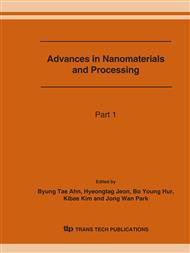p.239
p.243
p.247
p.251
p.255
p.259
p.263
p.267
p.271
Microstructural Study on the Wear Behavior of Cu-TiB2 Composites for Electrical Contact Materials
Abstract:
We have studied on the wear behavior of Cu-TiB2 composites, produced by thermal extraction, as a function of dispersed particle sizes and volume fractions of TiB2. The depth of subsurface zone was increased with applied loads from 25 μm with 20 N to 25 μm with 80 N. From the analyses results of the formation of wear debris generated by cracks between work hardened layer and matrix, wear mechanism is changed from abrasive wear to adhesive wear with increasing loads from 20 N to 80 N. The formation of sub-grains in the region of subsurface was clearly observed from the sample tested over 60 N loads. We attribute the formation of sub-grains to the plastic lubricant effect of TiB2 which gives arising from the contact stress and local heat generated during wear test.
Info:
Periodical:
Pages:
255-258
Citation:
Online since:
June 2007
Authors:
Keywords:
Price:
Сopyright:
© 2007 Trans Tech Publications Ltd. All Rights Reserved
Share:
Citation:


